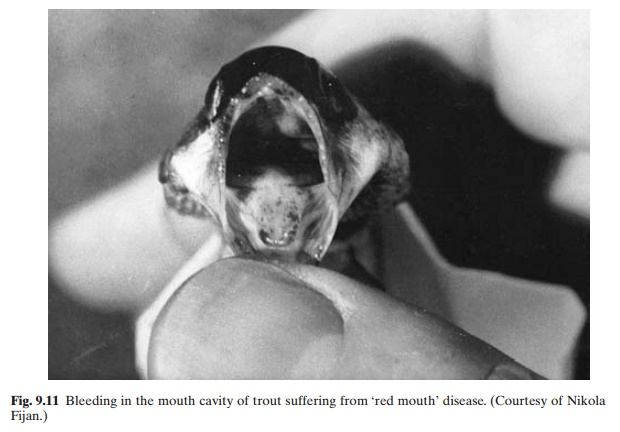Chapter: Aquaculture Principles and Practices: Health and Diseases
Enteric red mouth disease (ERM) - Bacterial diseases of aquaculture species
Enteric red mouth disease (ERM)
Enteric red-mouth disease is an acute to chronic bacterial disease of intensively cultured rainbow trout and other salmonids. The causative agent is a motile, gram-negative, rod-shaped bacterium, identified as Yersinia ruckeri, transmitted from fish to fish by contact and through water. It causes sustained low-level losses, but in severe epizootics mortality rates can be higher, exceeding 50 per cent. Surviving fish frequently become asymptomatic carriers.
Acute cases are seldom detected. The clinical symptoms are similar to infections of
Aeromonas hydrophila and A. salmonicida. Theaffected fish become dark and lethargic and refrain from feeding. Surviving carrier fish also show the same signs and may often have missing eyes or exophthalmia, with little avoidance reaction. During the acute stage of the disease, small bright haemorrhages occur along the gumline of the mouth and on the tongue, which together with the general inflammation give the characteristic ‘red mouth’ appearance (fig. 9.11). Small haemorrhages may develop on the belly and also at the base of the fins. A flaccid, fluid-filled stomach and haemorrhages of the mouth, when occurring together, give positive evidence of the disease. An enlarged dark spleen, haemorrhagic specks on the air bladder and pyloric caecae, and reddening of the posterior intestinal tract are other internal signs of the infection. Confirmatory diagnosis consists of the isolation of gram-negative motile rods of Y. ruckeri, with positive agglutination with rabbit anti-Y. ruckeri serum. The source of infection of the disease is asymptomatic carriers. No evidence of transmission from parent to progeny through eggs has been reported.

Susceptibility to the disease is obviously related to stress caused by handling or culture conditions. There does not seem to be any seasonality in its occurrence. The incubation period in young rainbow trout (7.5–10 cm) appears to be 5–19 days at about 15°C, and in young Atlantic salmon (6 cm) nine days after exposure at 12.5°C.
As detection of the pathogen in apparently healthy carrier fish is difficult, regular health inspection and monitoring are essential to prevent the disease. Disinfection of water supplies to hatcheries and rearing facilities is another means of disease prevention. Commercial vaccines against this disease are available, and though they may not always provide total protection, they can help to control the infection and reduce losses. Therapeutics recommended are sulphamerazine and oxytetracycline (terramycin). Vaccination and/or chemotherapy should be accompanied by avoidance of adverse environmental factors and excessive handling stresses.
Related Topics